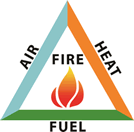Frequently Asked Questions
We have compiled a list of frequently asked questions that we receive from our customers. If you need any further help or advice, please do not hesitate to contact us and we'll be happy to help.
What is water mist?
Water mist contains water droplets as small as 25 Microns in diameter, allowing billions of droplets to be produced with small amounts of water.
What is Micron Size?
A Micron is a unit of measurement that measures less than 0.001mm in diameter.
How many droplets are produced from your fire extinguishers?
Our fire extinguishers produce over 22 billion droplets of water from 1L of water, giving them incredible fire extinguishing power, regardless of which size of water mist extinguisher you use.
Why is water mist safe to use on fires involving live electrical equipment?
The water mist droplets are so small and dispersed, they prevent electricity from travelling through it. In addition the extinguishers only use de-ionised water, which cannot conduct electricity! As a result the extinguisher can be used on live electrical equipment of up to 1000V (at a safety distance of 1m). The extinguisher has even been tested with a di-electrical test applying 35000 Volt and passed this test!
Why can a water mist extinguisher be used on burning liquids and fats, when normal water fire extinguishers cannot be used?
The droplets of a water mist extinguisher are so miniscule that they do not sink into the hot liquid, hence there is not the violent reaction associated with water entering a hot fat or burning liquid. Instead, the droplets evaporate just over the hot surface, rapidly cool the gases above the surface and exclude air from the area of the fire. This action kills the fire and cools the surface area.
How does water mist work?
The E-Series water mist fire extinguisher works by eliminating one or more sides of the fire triangle, extinguishing the fire and preventing re ignition in most cases.
What is the fire triangle?
The Fire Triangle (often refered to as the combustion triangle) is the basic model for understanding the elements required for most fires to burn.
As the triangle illustrates a fire needs 3 elements to burn: Fuel, Heat and Oxygen. If any of the individual elements are removed the fire will be extinguished.

How do fires start?
Heat is applied to combustible material, the temperature of the material rises and free radicals begin to form.
Free radicals and gases become airborne, and begin to bond with oxygen in the air. Once there is a sufficient amount of gas formed, it ignites (Pyrolysis).
The gases burn, generating heat and forming more free radicals and therefore, more gas.
What are free radicals?
Free radicals are atoms or groups of atoms that have at least one unpaired electron and are therefore unstable and highly reactive.
How is the fire extinguished?
The extinguisher is activated, removing 2 of the 3 Fire Triangle Elements. Heat is removed via the mist droplets and the oxygen particles via the steam.
The fire is extinguished. Steam (inert) formed by the mist during extinguishing continues to evaporate, dissipating the heat and oxygen from the fire source, cooling the material to prevent re-ignition.
Is there any collateral damage after discharge?
There is very little collateral damage after discharge, as described previously, the mist turns to steam and evaporates, both preventing re-ignition from cooling and suffocating the fire whilst maintaining a specific density in the air to allow you and those around you to breathe normally.
What are the advantages of water mist?
Water mist has many advantages over conventional methods;
- The extinguishers are safer to use as the agent is pure water with no additives and no fluorosurfactants.
- Water mist extinguishers can reduce the risk of making mistakes by using the wrong extinguisher on different classes of fire. The versatility of the water mist extinguisher makes staff training much easier.
- The extinguishers are exceptional at clearing smoke and most people that are killed in fire-related incidents do so from inhaling smoke as they try to escape rather than actually being caught up in the fire.
- A very broad spectrum of fires can be tackled including fires involving live electrical equipment
- The use of water means that the discharge is 100% environmentally friendly and can greatly help to reduce your companies’ carbon footprint.
- There is very little collateral damage from the use of a water mist extinguisher
What are the suitable situations to use water mist in?
Water mist extinguishers can be used on paper, wood, flammable gas, burning liquids, small fast fires and fires involving live electrical equipment and are therefore perfect for offices, workshops, churches, schools, homes and small kitchens. Water mist is not suitable for class T fires (burning metals such as Titanium, Magnesium, Lithium etc).




